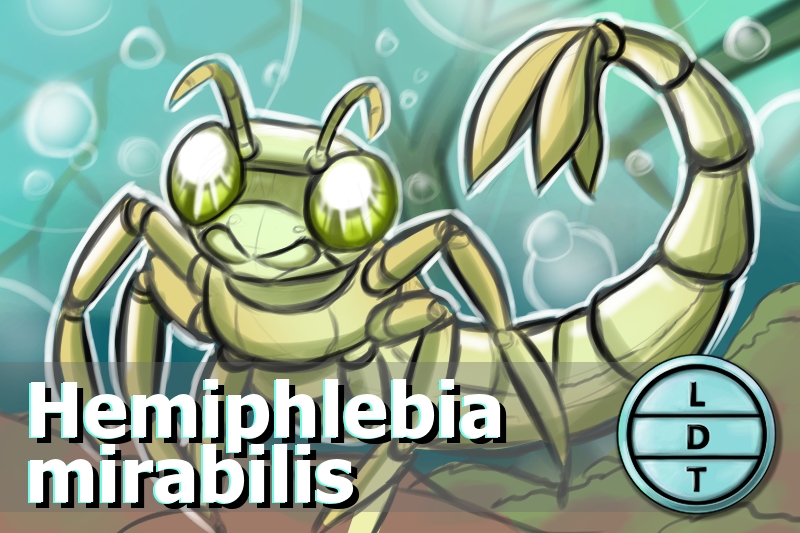“And today we’re talking about a damsel down under. But she’s not in distress! She’s thriving! But more on that later…”
Roses are red, the damselfly is blue. They usually fly, but also swim too. The time between hatching and adulthood is often a vulnerable period for insects. Their various stages are often slower and not as well equipped as their ending adult stage. Some insects just have lots of offspring to account for this, while others, like the damselfly, make the most of their instars. It’s all a part of nature’s air and sea show here in Life, Death, and Taxonomy.
Description of the Damselfly
Hemiphlebia mirabilis is a small flying insect with two pairs of translucent wings on each side of its thin body. They have shiny metallic looking green bodies that are thinner than a dragonfly. They have a long thin abdomen that connects to a short thick thorax. The most prominent feature of their heads is large protruding bulbous compound eyes. They also have very small antennas that you might miss if you just glanced at one.
Measure Up
Welcome to the beloved Measure Up segment. The official listener’s favorite part of the show! The part of the show when we present the animal’s size and dimension in relatable terms through a quiz that’s fun for the whole family. It’s also the part of the show that’s introduced by you when you send in audio of yourself saying, singing, or chittering the words “measure up” into ldtaxonomy at gmail dot com. We do have a new measure up intro today sent in by Brian. He sent it a while ago and I can’t believe we forgot to use it!
Wingspan
- Damselfly wingspans range from 18 mm (0.71 inches) to about 19 cm (7.5 inches).
- Our damselfly has a wingspan of about 22 mm (0.8 inches).
- How many damselfly wingspans go into the largest insect wingspan of all time?
- Hint: An ancestor of dragonflies and damselflies, called a griffinfly is thought to be the largest insect to ever exist. Wing fragments of the genus Meganeuropsis have been discovered in Kansas and Oklahoma.
- 32 damselflies. The reconstructed wing was 13 inches long with a wingspan of 28 inches.
Length
- Hemiphlebia mirabilis is about 24 mm long.
- How many damselflies go into the length of the griffinfly?
- Hint: It’s not proportional to the wingspan to body ratio of the damselfly.
- 18 damselflies. The total body length could be as much as 17 inches (430 mm).
Fast Facts About the Damselfly
Mirabilis is the only living species in its genus. It comes from southern Australia and Tasmania.
The damselfly loves freshwater ponds, swamps, and riverine lagoons. They especially like Discovery Bay Coastal Park in south-western Victoria.
In general, damselflies are all carnivorous, mainly eating other insects. They can be eaten by anything that frequents the pond, including birds, fish, frogs, reptiles, and other insects.
They have elaborate courtship displays where the male demonstrates his fitness to be a mate through his bright colors and flying abilities. The males have two sexual organs and will use both during mating. In the second phase of mating, the male and female will form a heart shape when connecting the necessary body parts.
Males may also deliver a nutritional package as a nuptial gift. In some cases, that’s not enough and the female will eat the male after mating.
Damselfly Major Fact: Bobbing Babies
Many insects that live near bodies of water use that water as a place to hide or protect their eggs. Like mosquitoes.
The damselfly is a bit different. While most of these types of insects hatch as terrestrial or airborne pests, most damselfly nymphs are completely aquatic.
After mating, the female ancient greenling will lay her eggs in the stem of an underwater plant, sometimes submerging herself for over 30 minutes to do so.
Some damselflies lay their eggs in slits in branches overhanging a river or lake, but the nymphs that hatch fall into the water and don’t leave until they reach adult stage.
These nymphs are agile predators that have a specialized lower jaw that shoots out and skewers water fleas, mosquito larvae, and other small aquatic animals.
But, you might ask, don’t insects need to breathe air just like we do? And the answer is yes, for the most part. But the damselfly and the dragonfly nymphs are relatively unique in that they actually have gills that they use to breathe. The gills are three antenna-looking things at the end of their abdomens.
They also use their trident tail to swim around and eat mosquito babies, which works for me.
Damselflies spend most of their lives in this stage. When they’re ready to start adulting by doing their taxes, opening a 401K, and applying for a mortgage, they wriggle out of the water, their thorax splits open like a spatchcocked turkey, and the adult form climbs out with its sparkly new wings and a soft, vulnerable body.
The adult then pumps hemolymph (bug blood) into its wings and back into its abdomen as its exoskeleton hardens and becomes more colorful. If it’s cold outside, it could take a few hours for it to be ready to fly. If it’s warmer, it could take just a half-hour.
Ending: So go for a swim, don’t rush adulthood, and be sure to target mosquitoes wherever they can be found like the damselfly here in LDT.
Thanks
Thank you to Casy for creating our theme song. To hear more of Casy’s music search Casy Michelle on Youtube.
Thank you to Brian for creating the episode art. See more of Brian’s art at xNamaru on Instagram or Twitter.

